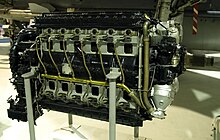|
Napier Dagger
The Napier Dagger was a 24-cylinder H-pattern (or H-Block) air-cooled engine designed by Frank Halford and built by Napier before World War II. It was a development of the earlier Napier Rapier. Design and developmentThe H-Block has a compact layout, as it essentially consists of two vertically opposed, flat-twelve inline engines lying side-by-side and driving side-by-side crankshafts. Another advantage is that since the cylinders are opposed, the motion in one is balanced by the opposite motion in the one on the opposite side, leading to very smooth running. The Dagger was remarkable for its fast rotation, running at up to 4,000 rpm but unlike the later Napier Sabre, it had conventional poppet valves. Although considered a masterpiece of engine design by Frank Halford, there were problems with cooling, maintenance, manufacturing and weight, which were not solved during the Dagger's lifetime and went unresolved well into the lifetime of the Napier Sabre, its successor. The Dagger powered the Hawker Hector army co-operation aircraft and the Handley Page Hereford, a variant of the Hampden bomber. The operational usefulness of the Hector was restricted by engine cooling problems, which made it unsuitable for operations in the tropics and the Hereford was found to be unsuitable for combat, because its Dagger VIII engines were noisy and unreliable. The Dagger was also used in the experimental Martin-Baker MB 2 fighter. Variants
1934 – 650 hp.
1938 – 755 hp
1938 – 725 hp
1938 – 1000 hp, intermediate altitude supercharger, initially known as E.108[1] Applications Some of these aircraft were test beds only.
Engines on displayA preserved Napier Dagger is on display at the Royal Air Force Museum London. Specifications (Napier Dagger III MS) Data from Lumsden[3] General characteristics
Components
Performance
See alsoRelated development Comparable engines Related lists References
NotesBibliography
External linksWikimedia Commons has media related to Napier Dagger. |
||||||||||||||
Portal di Ensiklopedia Dunia
